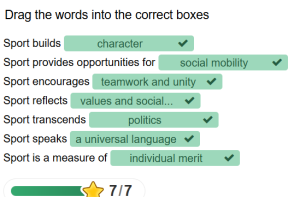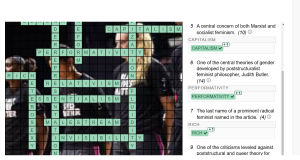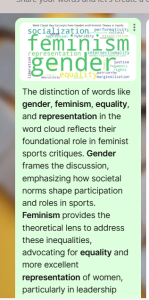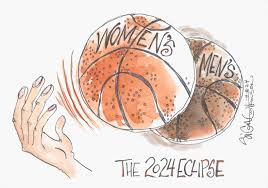1
Section One: The Fundamentals
A) What do we know about sport? What are common assumptions we make about sport and society?

| Sport and social justice can coexist when we use the power of sports to break down barriers and create positive change. Sports bring people together from all walks of life, which makes them a perfect space to challenge stereotypes and promote inclusion. When athletes stand up for causes like racial equality or gender rights, they spark important conversations and inspire others to think differently. Sports organizations also have a significant role to play. By ensuring everyone has equal opportunities to participate, whether through better access to resources or fair pay, they can help level the playing field. Policies that support LGBTQ+ athletes or programs that focus on underrepresented communities show how sports can genuinely reflect justice and fairness. At its best, sports are more than just competition; they are a platform to challenge injustice, celebrate diversity, and push society toward a more inclusive future. |
Exercise 3: Notebook prompt
What are some other metanarratives about sport that you are familiar with? Find an image or video clip or draw something yourself that captures this idea…
So what? Why does any of this matter? Does it matter? As something we grow up with – live with – play through – we don’t often interrogate the meanings of sport, and perhaps we don’t want to.
But being aware of these assumptions and metanarratives is especially important, I would argue, because of the centrality of sport to our everyday lives, the role that sport plays in shaping our childhood and worldviews and….. [finish that thought]
| Sport is often seen through specific big-picture lenses, like ideas about masculinity, competition, and even nationalism. These views shape how we think about athletes, how we value competition and the role of sports in our lives. For example, sports are often connected to traditional ideas of masculinity, where physical strength and toughness are celebrated, particularly for men. We also tie sport to national pride, especially when it comes to international events like the Olympics or the World Cup, where victories feel like a win for the whole country. But these ways of thinking about sports can limit our understanding. They often overlook how sports can reinforce inequalities, like gender or racial biases, and can promote harmful stereotypes. Awareness of these ideas is important because sports significantly shape our values and how we see ourselves. By recognizing these assumptions, we can start to question who really benefits from them and think about how sports can be more inclusive and meaningful for everyone.
|
B) What is social justice?
Exercise 4: Padlet Prompt
Think back to the last section and try to look at some of the ideas we discussed differently. How might sport and social justice actually co-exist?
Record any images, video clips, or gifs you added to the padlet and identify a point of intersection between sport and social justice (can be an issue or a barrier or a debate or something you would like to explore in more depth in this course) . Screenshot or paste in your response below.
| Sport and social justice seem like two different things, but they can actually work together in significant ways. While sports have often been used to reinforce inequalities, they also provide a powerful platform for addressing those issues. Athletes have long used their fame to speak out against racism, sexism, and other forms of injustice. Think about Muhammad Ali, Jackie Robinson, or Colin Kaepernick—each of them used their careers to highlight important social issues like racial inequality and police violence. Sports can also be a place for inclusivity and breaking down barriers. There are plenty of examples today where sport is used to create more opportunities for women, people with disabilities, and marginalized communities. Women’s leagues, adaptive sports, and programs that help people from all backgrounds get involved show how sports can be a tool for positive change. When we start to see sport as a space for social justice, it’s not just about competition anymore; it has become a way to challenge old ideas and push for equality for everyone.
|
C) Social Justice Reading
(note: this activity is optional!)
D) KINESIOLOGY AND SOCIAL JUSTICE
Exercise 5:
Exercise 6:
What are the implications of bodies-at-risk discourse and the refusal to understand the health gap from a social justice perspective, according to the authors of this article?
| In the article “Social Justice in Kinesiology, Health, and Disability,” the authors discuss how the “bodies-at-risk” idea can have negative consequences. This perspective often focuses on individuals, especially from marginalized groups, as being vulnerable or needing to be “fixed.” It overlooks the larger social and systemic issues that contribute to health disparities. When people are seen as “at risk,” it often leads to them being blamed for their health problems rather than addressing the root causes like poverty, racism, and unequal access to healthcare. Refusing to understand the health gap through a social justice lens worsens things. It focuses on personal responsibility rather than the bigger picture of how society’s structures affect people’s health. By ignoring the more significant issues, we miss the chance to create real change and make health outcomes more equal for everyone. The authors argue that we need to shift to a social justice approach, which challenges these more significant societal problems and works toward a fairer and healthier world for all.
|
Section Two: Sport Feminism
Exercise 7: Notebook Prompt
What is feminism? What does it mean to you? Choose one of the images below and explain how it captures your understanding of feminism (or find one that does speak to you and paste this into your pressbook with an explanation of why it matters to you.
| To me, feminism is about advocating for equality, breaking down barriers, and challenging the societal norms that restrict people’s potential based on their gender. It is about empowering individuals, particularly women, to take charge of their own lives and choices, ensuring that everyone has the opportunity to thrive without being limited by gender-based expectations. The image I chose of a strong woman flexing her muscles with the phrase “We can do it!” perfectly embodies this idea of empowerment. It symbolizes women’s strength and resilience, even in the face of adversity. It reminds us that women are capable of doing anything they set their minds to, challenging traditional gender roles and asserting their place in both the workforce and society. This image resonates with me because it celebrates women’s tireless effort and determination to overcome obstacles and break through barriers, embodying the core values of feminism: strength, equality, and the refusal to be held back.
|
Exercise 8: Notes Prompt (optional)
NB: Cornell notes is a great resource that teaches effective notetaking. Unfortunately, our system can’t save notes taken in the H5P app, so this is fully optional.
Exercise 9: Crossword Activity

Exercise 10: Padlet Prompt

|

|
|

